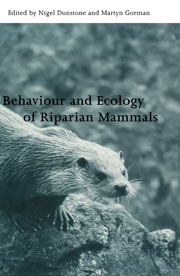Book contents
- Frontmatter
- Contents
- List of contributors
- Preface
- 1 Adaptations to the semi-aquatic habit and habitat
- 2 Physiological challenges in semi-aquatic mammals: swimming against the energetic tide
- 3 Diving capacity and foraging behaviour of the water shrew (Neomys fodiens)
- 4 Habitat use by water shrews, the smallest of amphibious mammals
- 5 The importance of the riparian environment as a habitat for British bats
- 6 A preliminary study of the behaviour of the European mink Mustela lutreola in Spain, by means of radiotracking
- 7 The demography of European otters Lutra lutra
- 8 Habitat use and conservation of otters (Lutra lutra) in Britain: a review
- 9 The relationship between riverbank habitat and prey availability and the distribution of otter (Lutra lutra) signs: an analysis using a geographical information system
- 10 Influence of altitude on the distribution, abundance and ecology of the otter (Lutra lutra)
- 11 Diets of semi-aquatic carnivores in northern Belarus, with implications for population changes
- 12 Otter (Lutra lutra) prey selection in relation to fish abundance and community structure in two different freshwater habitats
- 13 Diet, foraging behaviour and coexistence of African otters and the water mongoose
- 14 Feeding ecology of the smooth-coated otter Lutra perspicillata in the National Chambal Sanctuary, India
- 15 Population trends of hippopotami in the rivers of the Kruger National Park, South Africa
- 16 Reproductive strategies of female capybaras: dry-season gestation
- 17 The continuing decline of the European mink Mustela lutreola: evidence for the intraguild aggression hypothesis
- 18 Otters and pollution in Spain
- 19 The rapid impact of resident American mink on water voles: case studies in lowland England
- 20 Status, habitat use and conservation of giant otter in Peru
- Index
1 - Adaptations to the semi-aquatic habit and habitat
Published online by Cambridge University Press: 03 May 2010
- Frontmatter
- Contents
- List of contributors
- Preface
- 1 Adaptations to the semi-aquatic habit and habitat
- 2 Physiological challenges in semi-aquatic mammals: swimming against the energetic tide
- 3 Diving capacity and foraging behaviour of the water shrew (Neomys fodiens)
- 4 Habitat use by water shrews, the smallest of amphibious mammals
- 5 The importance of the riparian environment as a habitat for British bats
- 6 A preliminary study of the behaviour of the European mink Mustela lutreola in Spain, by means of radiotracking
- 7 The demography of European otters Lutra lutra
- 8 Habitat use and conservation of otters (Lutra lutra) in Britain: a review
- 9 The relationship between riverbank habitat and prey availability and the distribution of otter (Lutra lutra) signs: an analysis using a geographical information system
- 10 Influence of altitude on the distribution, abundance and ecology of the otter (Lutra lutra)
- 11 Diets of semi-aquatic carnivores in northern Belarus, with implications for population changes
- 12 Otter (Lutra lutra) prey selection in relation to fish abundance and community structure in two different freshwater habitats
- 13 Diet, foraging behaviour and coexistence of African otters and the water mongoose
- 14 Feeding ecology of the smooth-coated otter Lutra perspicillata in the National Chambal Sanctuary, India
- 15 Population trends of hippopotami in the rivers of the Kruger National Park, South Africa
- 16 Reproductive strategies of female capybaras: dry-season gestation
- 17 The continuing decline of the European mink Mustela lutreola: evidence for the intraguild aggression hypothesis
- 18 Otters and pollution in Spain
- 19 The rapid impact of resident American mink on water voles: case studies in lowland England
- 20 Status, habitat use and conservation of giant otter in Peru
- Index
Summary
Introduction
It has been asked by opponents of such views as I hold, how for instance, could a land carnivorous animal have been converted into one with aquatic habits; for how could the animal in its transitional state have subsisted?
Charles Darwin (1859), The Origin of SpeciesMammals exhibit a fascinating array of adaptations that suit them to their chosen habit and habitats. Many species show an association with water but the aquatic environment is a challenging one and presents many problems for those mammals that have chosen to utilize it. Hence, many species show compromise in the extent of their adaptations to amphibious life. Eisenberg (1981) uses the term semi–aquatic to include those species that must spend part of each 24 hour period out of the water. I use the term ‘semi–aquatic’ mammals to exclude those species where the association with water is to a large extent obligatory; such a distinction is somewhat arbitrary, since even the most highly evolved semi–aquatic mammals (e.g. pinnipeds) retain some dependence on a terrestrial substrate for part of their life, and many species of otter (Lutrinae) seem to be inseparably tied to waterways despite being incompletely adapted. Semi–aquatic mammals are phylogenetically diverse; representatives are found in several mammalian orders, including Monotremata, Marsupialia, Insectivora, Artiodactyla, Carnivora and, most commonly, Rodentia. Species from some 24 families of mammals have an association with aquatic habitats, although they vary in the extent to which they treat water as a medium in which to forage or to escape from predators or simply to traverse.
- Type
- Chapter
- Information
- Behaviour and Ecology of Riparian Mammals , pp. 1 - 16Publisher: Cambridge University PressPrint publication year: 1998
- 5
- Cited by

